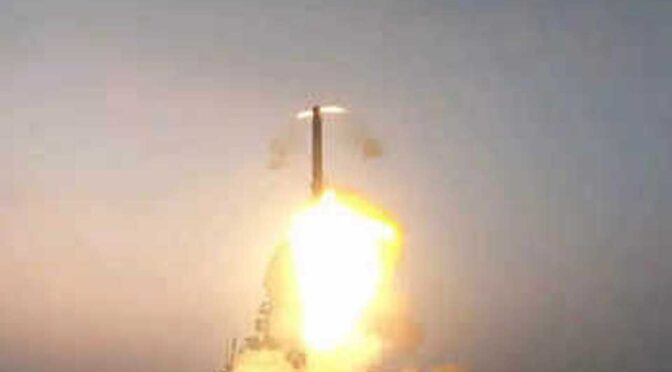THE ‘BRAHMOS’ CRISIS: MISFIRING AND THREAT OF CRISIS ESCALATION
Posted on : March 25, 2022Author : Raunak Bhattacharya

The Indo-Pakistani border is fraught with tensions, and with the rhetoric of conflict constantly augmented across both sides of the border in popular parlance, it must be taken into cognizance that every step undertaken, every military exercise conducted, is a step on thin ice. Geopolitically, in South Asia, the Indo-Pakistani border is further fraught with perplexity owing to the locus of armed power maintained by both the nuclear powers, thereby making the region deeply susceptible to anarchy, fuelled by nuclear conflict.
On March 9th, 2022, there was an inadvertent firing of a BrahMos missile that landed upon Pakistani soil, stirring up the Pandora’s box, amidst the already burgeoning Russo-Ukrainian crisis. This happens to be a very serious technical mishap with implications that are far-reaching in terms of their scope. The American and Chinese positions on the said event reflects changes from the stances that they’d have undertaken, perhaps 2 years back. The US stance towards accepting Indian probe and China mentioning about “dialogue and cooperation” between India and Pakistan, are indeed interesting stances, as they are both adhering to a centre of stage approach, rather than, direct involvement.
With Chinese Foreign Minister Wang Yi’s India visit coming up soon, this was something that has been much anticipated. In fact, going with Chinese Warring States Philosophy, this is a much-vaunted stance that China has taken; the American position is indeed understandable at this juncture, and does not require to be delved into deeper, for particularly two reasons, vis-à-vis India’s position particularly in the Quad arrangement and as a balancing variable against China, and the second, but contemporarily more viable, i.e., the Russo-Ukrainian Crisis.
The current situation and Pakistani muscle thumping at the instance of an accidental firing, raises multiple questions regarding the viability of the communication mechanism that happens to exist between the Indian and Pakistani defence personnel. A fact constantly raised across multiple spectrums is with regards to the behaviour of the respective actors, regarding the incident, Pakistan’s demand of a joint probe and its implications on the infringement of sovereignty as well as institutional dexterity, hold the same, unviable. However, it also raises the question vis-à-vis the Indo-Pakistan Escalation dynamics.
Richard Smoke defines escalation as an ‘action that crosses a saliency which defines the current limits of a war, and that occurs in a context where the actor cannot know the full consequences of his action, including particularly how this action and the opponent’s potential reaction(s) may interact to generate a situation likely to induce new actions that will cross still more saliences’. In other words, escalation refers to ‘the process by which the previous limits of a war are crossed and new ones established.’ Happymon Jacob, in his work, “Line on Fire: Ceasefire Violations and India-Pakistan Escalation Dynamics”, further probes into the different analyses on Escalation and its dynamics by Herman Kahn, as well as Pruitt and Rubin. The basic problem vis-à-vis their theorizations is that they focus chiefly upon the Cold War, and do not take cognizance of regional power struggles per se. In this context, it is important to take note of Jacob’s definition of Escalation, he defines ‘escalation as a sudden intensification of political, military, and diplomatic tensions between countries in a general atmosphere of adversarial relations that may or may not lead to a war’. Thus, following Jacob’s definition, this is one such instance wherein there has been a proliferation of tensions, an unnecessary augmentation of war preparedness, with causal reference that can be drawn to the incidence of a misfire, or in other words, an accident, something that can be apprised under the Autonomous Military Factors (AMF) leading to Ceasefire Violations (CFVs).
It must be noted herein that such incidents are not really precedented, as it is being portrayed time and again. However, the fact remains that unlike India, wherein the Civilian Government has much greater say, the Military Industrial Complex in Pakistan happens to be very strong. A longue durée approach reveals the existence of a martial culture that espouses a very staunch and unflinching masculinity, that has gone onto being a visible feature in Pakistani popular parlance. A rectitude that is guided by vengeance and spite against the larger power, fuelled by a cataclysmic fear of being overridden. Added to this mix, the AMFs are always more problematic. From simple border outpost brawls, the ambit of crisis grows wider, and happens to encompass a wider scope. The Sino-Pakistani Axis, that Andrew Small has mentioned, is obviously not actively condemning the affair, but the hawkish attitude of the axis is not likely to forget or forego something of this magnitude. It is pertinent to take cognizance of the same, and in fact, thorough safeguards must be in place, to exercise caution and in a way, restraint.
Raunak Bhattacharjee
Adjunct Researcher
Asia in Global Affairs





Leave a Reply